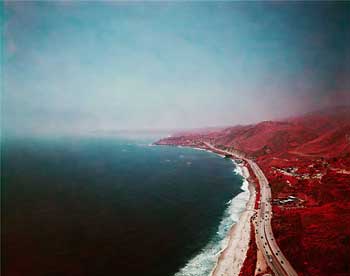The above video is excerpted from the Season 5 episode Fantasy, premiering on Wednesday, October 14, 2009 at 10pm (ET) on PBS (check local listings). Fantasy presents four artists — Cao Fei, Mary Heilmann, Jeff Koons, and Florian Maier-Aichen — whose hallucinatory, irreverent, and sublime works transport us to imaginary worlds and altered states of consciousness.
Who is Florian Maier-Aichen and what does he have to say about fantasy?
Florian Maier-Aichen was born in 1973 in Stuttgart, Germany; he lives and works in Cologne, Germany and Los Angeles. Alternately romantic, cerebral, and unearthly, Florian Maier-Aichen’s digitally altered photographs are closer to the realm of drawing and fiction than documentation. He embraces difficult techniques, chooses equipment that produces accidents such as light leaks and double exposures, and uses computer enhancements to introduce imperfections and illogical elements into images that paradoxically “feel” visually right, though they are factually wrong. Often employing an elevated viewpoint (the objective but haunting “God’s-eye view” of aerial photography and satellite imaging), Maier-Aichen creates idealized, painterly landscapes that function like old postcards. Interested in places where landscape and cityscape meet, he chooses locations and subjects from the American West and Europe—from his own neighborhoods to vistas of the natural world. Looking backwards for his influences, Maier-Aichen often reenacts or pays homage to the work of the pioneer photographers of the nineteenth century, sometimes even remaking their subject matter from their original standpoints. Always experimenting, he marries digital technologies with traditional processes and films (black-and-white, color, infrared, and tricolor), restoring and reinvigorating the artistry and alchemy of early photography.
On the subject of fantasy in art, Maier-Aichen describes liberties with which artists, including himself, have taken with picturing the American West, using his work The Best General View as a reference (in the forthcoming Season 5 book):
When I look at American landscape painting from the nineteenth century I always have in mind one painting of Yosemite by Albert Bierstadt. Yosemite is already such a theatrical place—almost like a too-drastic landscape—and Bierstadt just added more to it. He turned it into a complete fantasy by getting rid of the facts and enhancing every other aspect of Yosemite. Half Dome is an iconic image, but when I saw that Carleton Watkins had used it in one of his photographs back in the nineteenth century, it became more significant for me. Suddenly I wanted not to remake the same image but to go there and work with the subject.
I couldn’t access Watkins’s standpoint anymore because it was overgrown, so I used Glacier Point which is next door. It’s the most generic vista or viewpoint that you can get in Yosemite. It wasn’t a perfect day when I took the photograph, and I didn’t mind because it was just a starting point. I drew in the entire background with the blue sky and the clouds, and I brought in the bushes to make some foreground space. So in the end the image, except for Half Dome, is not really the way it looked when I took the picture.
What happens in Maier-Aichen’s segment in Fantasy this October?
“Photography used to be like alchemy back in the nineteenth century,” says Florian Maier-Aichen, who uses the computer to introduce imperfections and detach his photographs from reality, bringing them closer to the realm of drawing. Shown capturing his source images with a traditional large-format camera, the artist introduces painterly touches to his photographs with the aid of a digital stylus and tablet. “Illustration is just another level of abstracting,” he says, “it lifts you to another layer that is not necessarily linked to realism and it opens up your own world or your own myth-making.”
Inspired by the idealized quality of postcards and maps, the segment shows how the artist remakes images of landscapes, from a nostalgic nighttime scene of Stralsund in GDR times to epic vistas such as a pass in the Swiss Alps, ski slopes in the Sierras, Half Dome in Yosemite, and the failed St. Francis Dam near Santa Clarita (all works 2005-09). “Photography grew together with the discovery of the American West,” explains Maier-Aichen at his home and studio in Los Angeles, anchoring his fascination with the surrounding landscape to a romantic notion in Germany of California as “the end of the world.”

Florian Maier-Aichen. "Untitled," 2005. C-print, 72 x 90 1/2 inches. © Florian Maier-Aichen, courtesy Blum & Poe, Los Angeles and 303 Gallery, New York.
What else has Maier-Aichen done?
Florain Maier-Aichen studied at Högskolan för Fotografi och Film, Göteborg, Sweden; the University of Essen, Germany; and earned an MFA from the University of California, Los Angeles. Maier-Aichen’s work has appeared in recent major exhibitions at Museo Thyssen-Bornemisza, Madrid, Spain (2008); Museum of Contemporary Art, Los Angeles (2007); Yvon Lambert, New York (2007); and the Whitney Biennial (2006).
Where can I see more of Maier-Aichen’s work between now and the Art21 premiere this October?
Maier-Aichen is represented by Blum & Poe gallery in Los Angeles and 303 Gallery in New York.
What’s your take on Maier-Aichen’s inclusion in Season 5?
Tell us what you think by leaving a comment below!




Pingback: James Casebere interviewed by Roberto Juarez | Art21 Blog
Pingback: Season 5 Sneak Peek: Florian Maier-Aichen - BOMBLog
Pingback: What’s Cookin at the Art21 Blog: A Weekly Index | Art21 Blog
Pingback: Meet the Artist: Florian Maier-Aichen | Ask Your Question Here | Art21 Blog